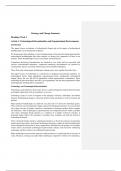Summary
Strategy and Change Summary (Lecture slides, Knowledge Clips, Tutorial Questions = Answers, Readings)
- Course
- Institution
PM for DISCOUNT :) I believe that this is one of my best summaries as it includes in detail the readings of the week, answered questions to articles for each tutorial (useful for exams as well), knowledge clips, and lecture slides. Following this all inclusive summary helped me achieve an 8,5 gr...
[Show more]



